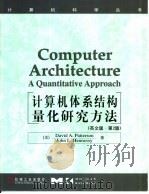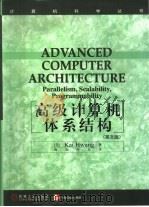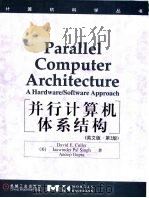《计算机体系结构量化研究方法 英文版·第2版》
| 作者 | (美)DavidA.Patterson等著 编者 |
|---|---|
| 出版 | 北京:机械工业出版社 |
| 参考页数 | 1006 |
| 出版时间 | 1999(求助前请核对) 目录预览 |
| ISBN号 | 7111074394 — 求助条款 |
| PDF编号 | 88812108(仅供预览,未存储实际文件) |
| 求助格式 | 扫描PDF(若分多册发行,每次仅能受理1册) |

1 Fundamentals of Computer Design1
References1
E.1 Implementation Issues for the Snooping Coherence Protocol1
Appendix E:Implementing Coherence Protocols1
D.1 Introduction1
Appendix D:An Alternative to RISC: The Intel 80x861
C.1 Introduction1
Appendix C: Survey of Risc Architectures1
B.1 Why Vector Processors?1
Appendix B:Vector Processors1
A.1 Introduction1
Xerox Paio Alto Research Center1
by DAVID GOLDBERG1
Appendix A: Computer Arithmetic1
Index1
1.1 Introduction1
D.2 80x86 Registers and Data Addressing Modes2
A.2 Basic Techniques of Integer Arithmetic2
C.2 Addressing Modes and Instruction Formats3
1.2 The Task of a Computer Designer3
B.2 Basic Vector Architecture3
C.3 Instructions : The DLX Subset5
E.2 Implementation Issues in the Distributed Directory Protocol6
1.3 Technology and Computer Usage Trends6
D.3 80x86 Integer Operations6
1.4 Cost and Trends in Cost8
D.4 80x86 Floating-Point Operations9
C.4 Instructions : Common Extensions to DLX9
D.5 80x86 Instruction Encoding11
Exercises12
C.5 Instructions Unique to MIPS13
A.3 Floating Point13
B.3 Two Real-World Issues : Vector Length and Stride15
C.6 Instructions Unique to SPARC15
D.6 Putting It All Together : Measurements of Instruction Set Usage15
A.4 Floating-Point Multiplication17
C.7 Instructions Unique to PowerPC18
1.5 Measuring and Reporting Performance18
C.8 Instructions Unique to PA-RISC19
D.7 Concluding Remarks22
B.4 Effectiveness of Compiler Vectorization22
A.5 Floating-Point Addition22
C.9 Concluding Remarks22
B.5 Enhancing Vector Performance23
D.8 Historical Perspective and References23
C.10 References25
A.6 Division and Remainder28
B.6 Putting It All Together : Performance of Vector Processors29
1.6 Quantitative Principles of Computer Design29
A.7More on Floating-Point Arithmetic34
B.7 Fallacies and Pitfalls35
B.8 Concluding Remarks37
A.8 Speeding Up Integer Addition38
B.9 Historical Perspective and References38
1.7 Putting it All Together:The Concept of Memory Hierarchy39
Exercises43
1.8 Fallacies and Pitfalls44
A.9 Speeding Up Integer Multiplication and Division46
1.9 Concluding Remarks51
1.10 Historical Perspective and References53
Exercises60
A.10 Putting It All Together61
A.11 Fallacies and Pit?alls65
A.12 Historical Perspective and References68
2.1 Introduction69
2 Instruction Set Principles and Examples69
2.2 Classifying Instruction Set Architecfures70
Exercises72
2.3 Memory Addressing73
2.4 Operations in the Instruction Set80
2.5 Type and Size of Operands85
2.6 Encoding an Instruction Set87
2.7 Crosscutting Issues:The Role of Compilers89
2.8 Putting it All Together : The DLX Architecture96
2.9 Fallacies and Pitfalls108
2.10 Concluding Remarks111
2.11 Historical Perspective and References112
Exercises118
3.1 What Is Pipelining?125
3 Pipellning125
3.2 The Basic Pipeline for DLX132
3.3 The Major Hurdle of Pipelining ——Pipeline Hazards139
3.4 Data Hazards146
3.5 Control Hazards161
3.6 What Makes Pipelining Hard to Implement?178
3.7 Extending the Dlx Pipeline to Handle Multicycle Operations187
3.8 Crosscutting Issues : Instruction Set Design and Pipelining199
3.9 Putting It All Together: The MIPS R4000 Pipeline201
3.10 Fallacies and Pitfalls209
3.11 Concluding Remarks211
3.12 Historical Perspective and References212
Exercises214
4.1 Instruction-Level Parallelism : Concepts and Challenges221
4 Advanced Pipelining and Instruction-Level Parallelism221
4.2 Overcoming Data Hazards with Dynamic Scheduling240
4.3 Reducing Branch Penalties with Dynamic Hardware Prediction262
4.4 Taking Advantage of More ILP with Multiple Issue278
4.5 Compiler Support for Exploiting ILP289
4.6 Hardware Support for Extracting More Parallelism299
4.7 Studies of ILP317
4.8 Putting It All Together : The PowerPC 620335
4.9 Fallacies and Pitfalls349
4.10 Concluding Remarks352
4.11 Historical Perspective and References354
Exercises362
5.1 Introduction373
5 Memory-Hierarchy Design373
5.2 The ABCs of Caches375
5.3 Reducing Cache Misses390
5.4 Reducing Cache Miss Penalty411
5.5 Reducing Hit Time422
5.6 Main Memory427
5.7 Virtual Memory439
5.8 Protection and Examples of Virtual Memory447
5.9 Crosscutting Issues in the Design of Memory Hierarchies457
5.10 Putting It All Together: The Alpha AXP 21064 Memory Hierarchy461
5.11 Fallacies and Pitfalls466
5.12 Concluding Remarks471
5.13 Historical Perspective and References472
Exercises476
6.1 Introduction485
6 Storage Systems485
6.2 Types of Storage Devices486
6.3 Buses-Connecting I/O Devices to CPU/Memory496
6.4 I/O Performance Measures504
6.5 Reliability, Availability, and RAID521
6.6 Crosscutting Issues : Interfacing to an Operating System525
6.7 Designing an I/O System528
6.8 Putting It All Together: UNIX File System Performance539
6.9 Fallacies and Pitfalls548
6.10 Concluding Remarks553
6.11Historical Perspective and References553
Exercises557
7 Interconnection Networks563
7.1 Introduction563
7.2 A Simple Network565
7.3 Connecting the Interconnection Network to the Computer573
7.4 Interconnection Network Media576
7.5 Connecting More Than Two Computers579
7.6 Practical Issues for Commercial Interconnection Networks597
7.7 Examples of Interconnection Networks601
7.8 Crosscutting Issues for Interconnection Networks605
7.9 Intemetworking608
7.10 Putting It All TOgether : An ATM Network of Workstations613
7.11 Fallacies and Pitfalls622
7.12 Concluding Remarks625
7.13 Historical Perspective and References626
Exercises629
8 Multiprocessors635
8.1 Introduction635
8.2 Characteristics of Application Domains647
8.3 Centralized Shared-Memory Architectures654
8.4 Distributed Shared-Memory Architectures677
8.5 Synchronization694
8.6 Models of Memory Consistency708
8.7 Crosscutting Issues721
8.8 Putting It All Together : The SGI Challenge Multiprocessor728
8.9 Fallacies and Pitfalls734
8.10 Concluding Remarks740
8.11 Historical Perspective and References745
Exercises755
1999《计算机体系结构量化研究方法 英文版·第2版》由于是年代较久的资料都绝版了,几乎不可能购买到实物。如果大家为了学习确实需要,可向博主求助其电子版PDF文件(由(美)DavidA.Patterson等著 1999 北京:机械工业出版社 出版的版本) 。对合法合规的求助,我会当即受理并将下载地址发送给你。
高度相关资料
-

- 计算机英语 第2版
- 1997 北京:清华大学出版社
-

- 计算机系统结构
- 1984 西北电讯工程学院出版社
-

- 计算机系统结构 第2版
- 1984 西安:西安电子科技大学出版社
-

- 质量控制统计方法 英文版 第7版
- 1999 北京:机械工业出版社
-

- 企业研究方法 英文版 第6版
- 1998 北京:机械工业出版社
-

- 实用计算机体系结构
- 1982 北京:人民邮电出版社
-

- 计算机系统结构
- 1996 北京:高等教育出版社
-

- 高级计算机体系结构 英文
- 1999 北京:机械工业出版社
-

- 并行计算机体系结构 英文版·第2版
- 1999 北京:机械工业出版社
-

- 砌体结构 第2版
- 1992 武汉:武汉工业大学出版社
-

- 砌体结构 第2版
- 1995 北京:中国建筑工业出版社
-

- 计算机体系结构
- 1988 北京:中国铁道出版社
-

- 计算机系统结构
- 1997 重庆:重庆大学出版社
-

- 计算机体系结构
- 1988 长沙:国防科技大学出版社
-

- 计算机体系结构技术
- 1987 北京:科学出版社
提示:百度云已更名为百度网盘(百度盘),天翼云盘、微盘下载地址……暂未提供。➥ PDF文字可复制化或转WORD